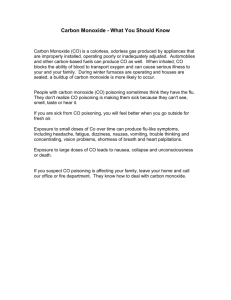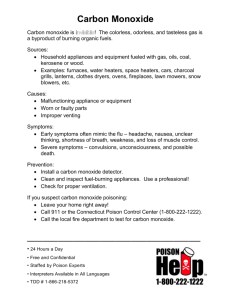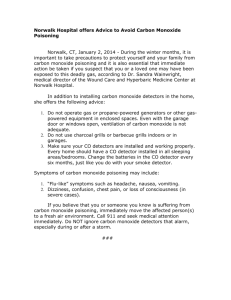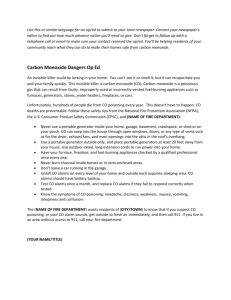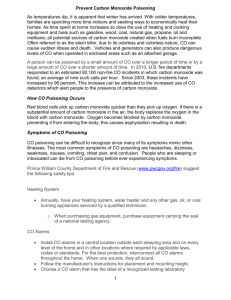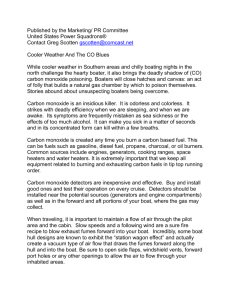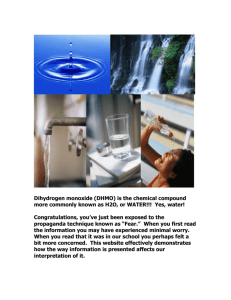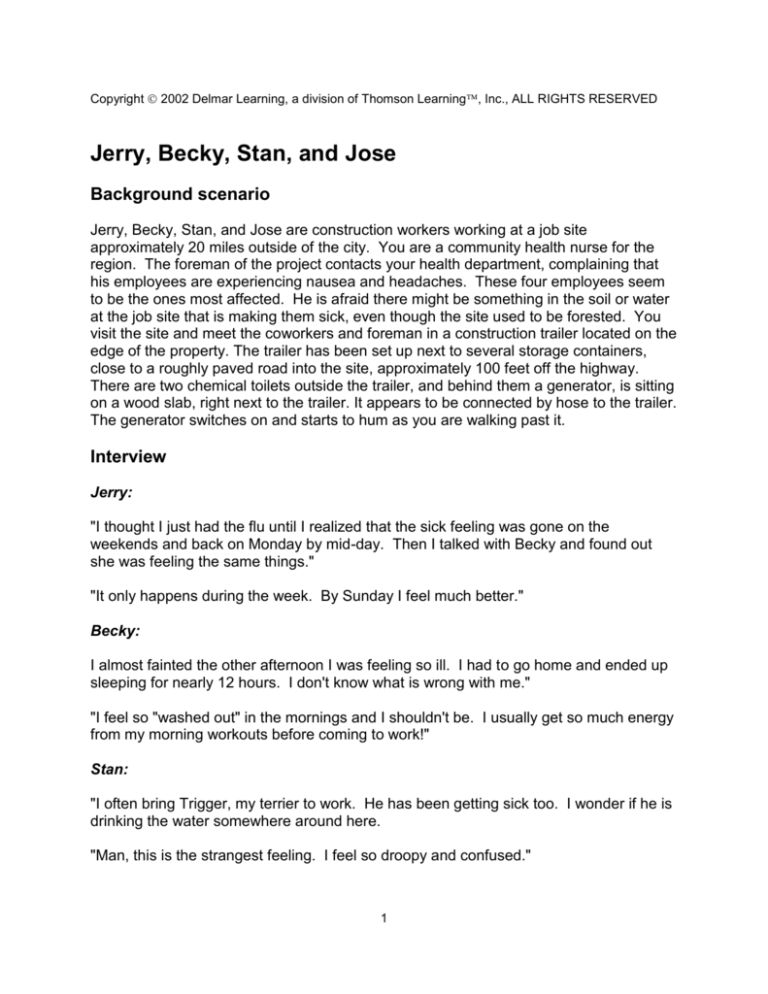
Copyright 2002 Delmar Learning, a division of Thomson Learning, Inc., ALL RIGHTS RESERVED
Jerry, Becky, Stan, and Jose
Background scenario
Jerry, Becky, Stan, and Jose are construction workers working at a job site
approximately 20 miles outside of the city. You are a community health nurse for the
region. The foreman of the project contacts your health department, complaining that
his employees are experiencing nausea and headaches. These four employees seem
to be the ones most affected. He is afraid there might be something in the soil or water
at the job site that is making them sick, even though the site used to be forested. You
visit the site and meet the coworkers and foreman in a construction trailer located on the
edge of the property. The trailer has been set up next to several storage containers,
close to a roughly paved road into the site, approximately 100 feet off the highway.
There are two chemical toilets outside the trailer, and behind them a generator, is sitting
on a wood slab, right next to the trailer. It appears to be connected by hose to the trailer.
The generator switches on and starts to hum as you are walking past it.
Interview
Jerry:
"I thought I just had the flu until I realized that the sick feeling was gone on the
weekends and back on Monday by mid-day. Then I talked with Becky and found out
she was feeling the same things."
"It only happens during the week. By Sunday I feel much better."
Becky:
I almost fainted the other afternoon I was feeling so ill. I had to go home and ended up
sleeping for nearly 12 hours. I don't know what is wrong with me."
"I feel so "washed out" in the mornings and I shouldn't be. I usually get so much energy
from my morning workouts before coming to work!"
Stan:
"I often bring Trigger, my terrier to work. He has been getting sick too. I wonder if he is
drinking the water somewhere around here.
"Man, this is the strangest feeling. I feel so droopy and confused."
1
Jose:
I'm so glad the construction company brought this trailer out to the site. We have an air
conditioner hooked up to the generator. It is brand new, so at least we can cool off
while we are resting. I go there a lot, but I keep getting sicker."
"If I can't get it together soon, I think I'm going to get fired."
Examination
Vital signs: (Jose only)
Temperature: 98.2°F
Pulse: 100
Respiratory rate: 32
Blood pressure: 113/73
Observation
Clients appear to be slightly short of breath.
Clients appear to be very listless and fatigued.
Laboratory report:
Low levels of Carbon Monoxide detected.
As time passes
In the process of conducting interviews and physical examinations, as you remove the
blood pressure cuff from Hose's arm, you suddenly feel a wave of dizziness, followed by
a vague sense of nausea. You realize you are getting a little headache. You ask the
others how they are feeling and realize that everyone is getting sick. You stop the
interviews and ask everyone to go outside for a breath of fresh air. After a few minutes
your head seems to clear a little bit. On a hunch, you call 911 and ask for a unit to
respond to your location to test for the presence of carbon monoxide (CO). The fire
department reports that carbon monoxide levels in the trailer were over 400 parts per
million.
Further investigation indicates that when the air conditioner was running a defective
generator muffler was allowing carbon monoxide to be sucked back into the trailer.
Occupants of the trailer were being exposed to carbon monoxide. The defect was
repaired and a carbon monoxide detector was installed in the trailer. No further
symptoms were reported.
Background education
Carbon monoxide is a colorless, odorless, and deadly gas produced by incomplete
combustion of carbon containing fossil fuels. Carbon monoxide combines reversibly
2
with blood hemoglobin to form carboxyhemoglobin, which reduces the ability of the
hemoglobin to carry oxygen to the tissues. Thus, inhalation of carbon monoxide causes
tissue hypoxia by preventing the blood from carrying sufficient oxygen. This reduction
in oxygen-carrying capacity of the blood is proportional to the amount of
carboxyhemoglobin formed. Factors that speed respiration and blood circulation
accelerate the rate of carboxyhemoglobin formation. Exercise, increased temperature,
high altitude, and anemia increase the hazard associated with carbon monoxide
exposure. Other conditions that increase risk are hyperthyroidism, obesity, bronchitis,
asthma, preexisting heart disease, and alcoholism. Tissue hypoxia particularly affects
the heart, central nervous system, and brain. In the heart, carbon monoxide causes
irregular heart rate, loss of blood pressure, and premature ventricular contractions.
Severe carbon monoxide poisoning can cause cerebral edema, and long-term central
nervous system disturbances.
Carbon monoxide exposure can be either acute or chronic. With acute exposure, the
signs and symptoms are flu-like and intense. They include headache, flushing, nausea,
vomiting, vertigo, weakness, reduced coordination, difficulty breathing, irritability,
confusion, disorientation, unconsciousness, and death. In persons with pre-existing
heart disease, and arteriosclerosis, symptoms may include angina and leg pain.
Lower levels of exposure cause flu-like symptoms of headache, dizziness, visual
disturbances, fatigue, or nausea. These symptoms are often discounted or overlooked,
especially if the person moves in and out of the toxic environment. Symptoms felt at
work, for example, abate at home or on days off work. Repeated bouts of carbon
monoxide poisoning may cause persistent signs and symptoms, such as anorexia,
headache, lassitude, dizziness, and ataxia.
The current Occupational Safety and Health Administration (OSHA) permissible
exposure limit (PEL) for carbon monoxide is 50 parts per million (ppm) of air (55
milligrams per cubic meter) as an 8-hour time-weighted average (TWA) concentration.
The National Institute for Occupational Safety and Health (NIOSH) has established a
recommended exposure limit (REL) for carbon monoxide of 35 ppm (40 milligrams per
cubic meter) as an 8-hour time-weighted average and 200 ppm (229 milligrams per
cubic meter) as a ceiling.
If low levels of exposure are suspected, biological monitoring may be undertaken. This
involves sampling the blood to provide an index of exposure. A readily available
biological monitoring method for carbon monoxide involves the measurement of
carboxyhemoglobin concentration in the blood by means of automated visible
spectrophotometry. The recommended maximum allowable carboxyhemoglobin level
for workers is 5 percent, which corresponds to an 8-hour exposure of 35 ppm.
Exposure at the current permissible exposure limit (PEL) of 50 ppm for 8 hours will yield
a carboxyhemoglobin level of 8 to 10 percent in most workers.
A baseline sample should be taken and analyzed to determine background
carboxyhemoglobin levels resulting from other causes, including smoking, various
diseases, and non-occupational exposures. It is especially important that smokers and
3
non-smokers be measured separately. The carboxyhemoglobin levels in smokers
range from 3 to 10 percent and may be as high as 20 percent in cigar smokers.
Determination of a worker's exposure to airborne carbon monoxide can be made using
an Ecolyzer direct reading field instrument. This instrument is capable of detecting
carbon monoxide concentrations between 0 and 600 ppm (parts per million).
Good indoor air quality is an important component in an environment in which the
surroundings contribute to productivity, comfort, safety, and a sense of well-being.
Indoor air quality is determined by adequate air ventilation, the detection and control of
airborne hazards, and the maintenance of acceptable temperature and relative humidity
levels. Prevention of carbon monoxide poisoning starts with education of employers
and workers about work-related hazards, placement of workers in jobs that does not
jeopardize safety or health, early detection of adverse health effects, and referral of
workers for diagnosis and treatment.
Emergency response to carbon monoxide poisoning is designed to restore oxygen to
the body as quickly as possible. Rescuers move the victim to open air as quickly as
possible and check for pulse and breathing. They will start CPR, if necessary. If
breathing is absent, but there is a pulse, mouth-to-mouth respiration is initiated. Query
others to determine the length and intensity of exposure. Oxygen is administered at
100% by tight- fitting facemask. Paramedic or medical responses includes a drawn
blood sample for Carboxyhemoglobin analysis, performing electrocardiogram
monitoring, preparing for the possibility of generalized seizures, and starting an IV of
normal saline. The physician may order the patient to be moved to a Hyperbaric
Oxygen therapy facility. Clients who have been exposed to mild levels of carbon
monoxide will recover slowly once removed from the source of the contamination.
List your findings and conclusions:
Carbon Monoxide poisoning due to faulty generator exhaust system
Nursing diagnoses:
00037 Risk of Poisoning
00024 Ineffective tissue perfusion
00030 Impaired gas exchange
00126 Deficient knowledge (related to sources and symptoms of carbon monoxide
poisoning)
Quiz
1. A teenager who was working on his 1964 Chevy in a closed his garage tells the
nurse that got dizzy and had a severe headache after working on his car for several
hours. He says he was running the car off and on. He says that he feels better but
wants to know why he was dizzy. After further assessment the client is diagnosed with
4
mild carbon monoxide poisoning. To answer the client's query the nurse tell him that
carbon monoxide poisoning makes someone dizzy because
a. Carbon monoxide slows breathing which reduces the ability of the lungs to carry
oxygen to the tissues.
b. Carbon monoxide combines irreversibly with blood hemoglobin and slows breathing.
c. Carbon monoxide replaces oxygen in the lungs and reduces the amount of oxygen
that the lungs can supply to the tissues.
d. Carbon monoxide combines reversibly with blood hemoglobin to form
carboxyhemoglobin, which reduces the ability of the hemoglobin to carry oxygen
to the tissues.
2. A client calls the community health hotline to ask about breathing difficulties
experienced by workers in a check cashing business located next to a fast food drive-up
window. He says that he can't smell anything but that he suspects the wind is blowing
fumes from the idling cars into the ventilation system. The nurse informs the client that
carbon monoxide is
a. Colorless and odorless.
b. Smells like rotten eggs.
c. Not dangerous.
d. Derived from oxygen
3. A doctor orders tests for carbon monoxide poisoning on a client. Acute carbon
monoxide poisoning can be measured with a
a. Blood test
b. Skin test
c. Throat culture
d. Hair sample
4. The sales staff for a condominium complex under construction work in a trailer
located next to the underground parking area exhaust vents. The construction crew
ventilates several large generators using these vents. The workers in the trailer report
feeling ill and the supervisor asks the nurse for assistance. The nurse suspects the
carbon monoxide contamination from the garage vents. She knows that symptoms of
carbon monoxide poisoning include
a. Nausea, upset stomach, headaches
b. Coughing, dry throat, runny nose
c. Vomiting, abdominal pain, diarrhea
d. Cardiac arrest, sneezing, headache
5. The nurse called to the construction site where workers have been diagnosed with
chronic carbon monoxide poisoning tells the workers about the effects of the poisoning.
5
Which of the following is an accurate statement of the effects?
a. Carbon monoxide causes permanent skin changes.
b. Carbon monoxide causes symptoms to diminish as the body adapts to higher levels
of carbon monoxide in the blood
c. Carbon monoxide causes flu-like symptoms that come and go.
d. Carbon monoxide can be detected in hair samples.
6. A man working on a road construction project is brought into the clinic nearly
unconscious. He is diagnosed with severe carbon monoxide poisoning. Which of the
following is possible if a person is the victim of severe carbon monoxide poisoning?
a. The person might have an unexpected generalized seizure.
b. The person rarely needs CPR.
c. The person needs immediate IV glucose.
d. The person would be combative and belligerent.
7. A parking garage exhaust system has not been working properly. The community
health nurse was called to the scene when several workers complained of being short of
breath with nausea and headaches. Which of the following statements by the garage
supervisor tells the nurse that he understands the issue?
a. "We need to fix the exhaust system soon. It's only been out a week. It should be up
and running by this time next week."
b. "We have fixed the exhaust system. We are training the employees how to
recognize the early symptoms of carbon monoxide poisoning. We are providing
carbon monoxide detectors in appropriate areas."
c. "We will train the employees to sniff for the odor of rotten eggs. This can't happen
again."
d. "We have started a program where the employees can rotate working in the parking
garage."
8. A 19-year-old girl had been listening to her favorite CD in her car while in a closed
garage. She was running the car at the same time for air conditioning. Her mother
brings her to a clinic saying her daughter fainted when she went into the house. The
nurse suspects carbon monoxide poisoning. Carbon monoxide poisoning can affect the
respiratory system with symptoms of
a. Shortness of breath and rapid breathing.
b. Coughing up blood.
c. Rapid development of rales and rhonchi.
d. Bloody nose.
9. A 42-year-old male is found unconscious at his station in a parking garage. From the
initial assessment it is apparent that the client has been exposed to high levels of
6
carbon monoxide. Which of the following is the most appropriate action for the nurse to
take?
a. Deliver oxygen via nasal cannula.
b. Deliver oxygen at 100% via airtight mask.
c. Wait until the client wakes up to do anything else.
d. Deliver oxygen at low levels to avoid additional respiratory depression.
10. A construction worker falls ill. His co-workers report that he lost consciousness and
his body started jerking uncontrollably. They say the exhaust system on his backhoe is
broken and leaks into the closed cab. The nurse suspects carbon monoxide because
CO poisoning can affect the nervous system with
a. Acute schizophrenia.
b. Acute psychosis.
c. A generalized sense of euphoria.
d. Convulsions.
Copyright © 2002 by Delmar Learning, a division of Thomson Learning, Inc. ALL RIGHTS RESERVED.
7

